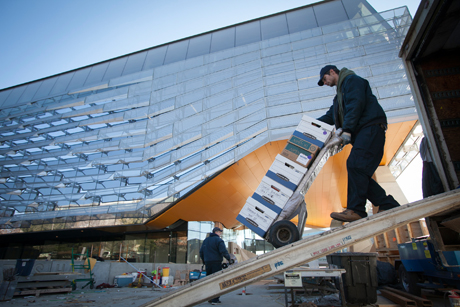Cornell's new Gates Hall is not what it seems
By H. Roger Segelken


Here’s what it’s not – that gleaming, streaming, futuristic home for Computing and Information Science, called Bill & Melinda Gates Hall, that opened for business this week:
It’s not a stack of luxury boxes overlooking baseball at Hoy Field. Every Big Red fan on the four-level building’s south side gets a season-ticket view from their same-sized, 160-square-foot offices. Between games, first-year CIS Ph.D. students get the best view of all – northwestward across campus to a sunset-lit Cayuga Lake.
Those wavy, reflective “scales” cloaking Gates Hall are not computing’s homage to the Green Dragon. Upon closer inspection, from inside, they are perforated metal and are purely decorative. But dozens of green features – like the chilled-beam, passive-convection AC system – are expected to get a LEED (Leadership in Energy and Environmental Design) “gold” rating.
Best of all, Gates is nothing like the dark and blocky places where CIS folks toiled since the college-level program began 14 years ago.
“We told the architects we needed light, light, light,” said Kavita Bala, associate professor of computer science. “I work in computer graphics, and it’s important to have bright, open spaces where ideas can flow.”
“Information science is a highly creative and innovative field, so we asked for nontraditional design to inspire us,” said Jeffrey Hancock, professor of communication and co-chair of information science. “Curved lines intersecting with linear angles, lots of glass and light – not just in the common, collaborative spaces but in every office, lab and teaching space” were on Hancock’s wish list.
“Inspiring space for the students,” Bala requested of the architects, Morphosis, especially “transparent labs to let our innovations be shared in real time with the world.”
Morphosis’ design director, Pritzker Prize-winner Thom Mayne, must have listened. Early in the design process (Gates has been under construction since 2012), he promised CIS faculty and students a space “to capture and express the dynamic and transformative power of the discipline it houses.”
$42 million worth of construction later (the overall project cost $60 million), general contractors Welliver McGuire Inc. and a skilled cast of hundreds are packing up their gear. Morphosis turns its advanced computational modeling and CAD tools to the next Cornell project, the Cornell NYC Tech campus’s first academic building on Roosevelt Island.
“Bill and Melinda Gates Hall is a real game-changer for CIS,” said Haym Hirsh, dean of the Faculty of Computing and Information Science. “Being in one location will facilitate research collaboration – and expand and strengthen the educational experience that we provide our students.”
Media Contact
Get Cornell news delivered right to your inbox.
Subscribe